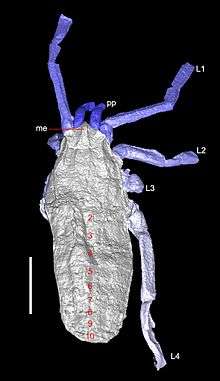Plesiosiro
Plesiosiro is an extinct arachnid genus known exclusively from only nine specimens from the Upper Carboniferous of Coseley, Staffordshire, United Kingdom[1][2]. The genus is monotypic, represented only by the species Plesiosiro madeleyi described by Reginald Innes Pocock in his important 1911 monograph on British Carboniferous arachnids. It is the only known member of the order Haptopoda.[3] The original locality from which these fossils originate is no longer available thus it is unclear whether any further examples will be found.
| Plesiosiro | |
|---|---|
 | |
| CT scan | |
| Scientific classification | |
| Kingdom: | Animalia |
| Phylum: | Arthropoda |
| Subphylum: | Chelicerata |
| Class: | Arachnida |
| Order: | †Haptopoda Pocock, 1911 |
| Genus: | †Plesiosiro Pocock, 1911 |
| Species: | †P. madeleyi |
| Binomial name | |
| †Plesiosiro madeleyi Pocock, 1911 | |
The original fossils have been redescribed in detail by Alexander Petrunkevitch in 1949[4] and Dunlop in 1999[2]. A supposed example from the Coal Measures of Lancashire is a misidentification.
Relationships
Relationships with other arachnids are obscure. Plesiosiro means "close to Siro", which is a genus of cyphophthalmid (Cyphophthalmi); the most primitive group of the living harvestmen (Opiliones). These harvestmen do, in some ways, resemble the reconstructed body plan of the haptopods.
Revisions have confirmed that Haptopoda should be treated as a separate and independent order. A 2007 study tentatively recognised a group named Schizotarsata Shultz, 2007[5] comprising Haptopoda, Amblypygi (whip spiders), Uropygi (whip scorpions) and Schizomida (schizomids), which has been recovered subsequently in a number of other phylogenies to include fossils[6][7][8][1]. All share the character of a subdivided tarsus (or foot) which gives the group its name.
Names
The order has also been called Haptopodida; the ending -ida originated when Petrunkevitch (1955)[9] tried to standardize the endings of the arachnid orders.
Haptopoda originates from Greek "haptos" (= tangible, subject to the sense of touch) + "pous, podos" (= foot) and refers to its quite long front pair of legs with their subdivided tips which look as though they might have been used to 'feel' their way around in front of the animal.
References
- Garwood, Russell J.; Dunlop, Jason (2014). "Three-dimensional reconstruction and the phylogeny of extinct chelicerate orders". PeerJ. 2: e641. doi:10.7717/peerj.641. ISSN 2167-8359.
- Dunlop, Jason A. (2011). "A redescription of the Carboniferous arachnid Plesiosiro madeleyi Pocock, 1911 (Arachnida: Haptopoda)". Transactions of the Royal Society of Edinburgh: Earth Sciences. 90 (1): 29–47. doi:10.1017/S0263593300002492. ISSN 0263-5933.
- Reginald Innes Pocock (1911). A Monograph of the Terrestrial Carboniferous Arachnida of Great Britain. Monographs of the Palaeontographical Society, London. pp. 1–84.
- Alexander Petrunkevitch (1949). "A study of Palaeozoic Arachnida". Transactions of the Connecticut Academy of Arts and Sciences. 37: 69–315.
- Jeffrey W. Shultz (2007). "A phylogenetic analysis of the arachnid orders based on morphological characters" (PDF). Zoological Journal of the Linnean Society. 150 (2): 221–265. doi:10.1111/j.1096-3642.2007.00284.x.
- Wang, Bo; Dunlop, Jason A.; Selden, Paul A.; Garwood, Russell J.; Shear, William A.; Müller, Patrick; Lei, Xiaojie (2018). "Cretaceous arachnid Chimerarachne yingi gen. et sp. nov. illuminates spider origins". Nature Ecology & Evolution. 2 (4): 614–622. doi:10.1038/s41559-017-0449-3. ISSN 2397-334X.
- Garwood, Russell J.; Dunlop, Jason A.; Knecht, Brian J.; Hegna, Thomas A. (2017). "The phylogeny of fossil whip spiders". BMC Evolutionary Biology. 17 (1). doi:10.1186/s12862-017-0931-1. ISSN 1471-2148.
- Garwood, Russell J.; Dunlop, Jason A.; Selden, Paul A.; Spencer, Alan R. T.; Atwood, Robert C.; Vo, Nghia T.; Drakopoulos, Michael (2016). "Almost a spider: a 305-million-year-old fossil arachnid and spider origins". Proceedings of the Royal Society B: Biological Sciences. 283 (1827): 20160125. doi:10.1098/rspb.2016.0125. ISSN 0962-8452.
- Alexander Petrunkevitch (1955). "Arachnida". In R. C. Moore (ed.). Part P, Arthropoda 2. Treatise on Invertebrate Paleontology. Lawrence: Geological Society of America and University of Kansas Press. pp. 42–162.